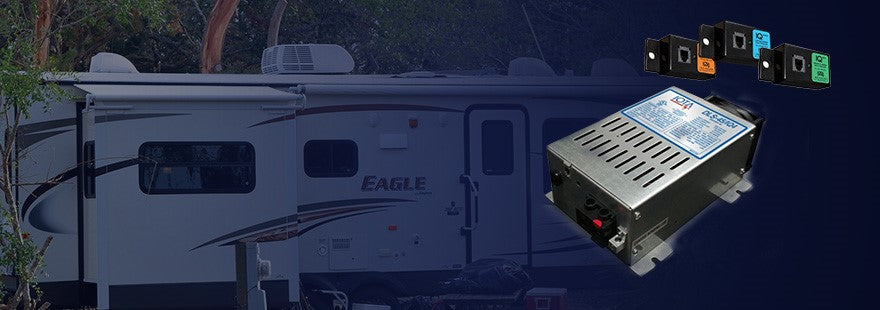When choosing a new RV battery charger, you may think all chargers are created equal. But in reality, a newer, smart RV converter charger can actually improve battery life and the overall quality of the charge. But what makes a smart converter charger so smart? Find out what exactly a smart RV converter charger, what sets it apart from your standard battery converter charger and why more and more RV owners are opting for a smart battery converter charger.
RV Converter Charger Basics
An RV converter charger converts 110-volt AC (household) power into 12-volt DC (battery) power while simultaneously charging the RV’s batteries.
A standard battery charger is meant to charge a battery as quickly as possible. It does this through a fixed voltage method called single-stage charging. This type of charger is pretty common in most low- and mid-range RV battery chargers. But charging a battery too fast with too much power or overcharging the battery can actually damage it, reducing its overall performance capacity and shortening its lifespan. This is where a smart RV converter charger comes into play.
A smart RV battery charger actually charges the battery in stages, which allows a more complete charge while protecting the battery from damage.
The Intuitive Stages of a Smart Converter Charger
The primary advantage of a smart converter charger (sometimes referred to as a trickle charger) is its intuitive battery charging stages. Multi-stage charging is a more sophisticated method that most often uses three to four stages of low-voltage charging to prevent overcharging.
Stage 1: Bulk
This is the core part of the charging cycle, in which the batteries are rapidly charged from a low charge to a nearly 80-90% charge. The bulk stage will constantly charge the battery at 25% of the amp capacity. As the battery charge increases, the battery accepts or “absorbs” a smaller and smaller portion of the electricity coming into it. So, the smart converter charger increases the voltage as needed in order to keep the flowing amps at a constant rate. Once the charge reaches 80-90% the smart converter charger will switch to the next stage.
Stage 2: Absorption
The absorption stage is about maintaining a lower but constant flow of voltage to the battery, and letting the battery accept as much as it's willing to, at its own rate. During this stage, absorption tapers, so the charge rate is more gradual as the charge amperage decreases. After slowly charging the last 10-20% of the battery, a smart converter charger will switch to float mode.
Stage 3: Float
Float mode or float voltage is the stage during which a battery is maintained after being fully charged to 100%. During this mode, the battery will maintain that capacity by compensating for self-discharge of the battery. The float stage, in more simplistic terms, keeps the batteries topped off at a lower voltage in order to prevent electrolyte loss by overheating the water in the battery.
Stage 4: Equalize
During the equalize stage, which isn’t always a part of a multi-stage charging process, the battery voltage is supercharged in order to remove any sulfur build-up that can easily accumulate on the battery plates. A build-up of sulfur reduces battery life and the overall quality of the charge.
While both single-stage and multi-stage converter chargers work well, the best RV battery charger is a smart converter charger, like a PowerMax battery charger. More recent standard RV battery chargers are much improved when compared to older models, but you may still want to upgrade or have a backup charger on hand in the case of an emergency.
Shop for Your New Smart Converter Charger From Boat & RV Accessories
Whether you’re looking for RV battery chargers, towing equipment or appliances, Boat & RV Accessories has everything you need to fully enjoy your RV or camper. Be sure to check out our buying guides for help finding everything from an RV furnace to a vent fan. Have a question or need more information? Feel free to reach out to our customer service department today.

